
E-mail: font@focusonnature.com
Phone: Toll-free in USA 1-888-721-3555
or 302/529-1876
 |
PO Box 9021,
Wilmington, DE 19809, USA E-mail: font@focusonnature.com Phone: Toll-free in USA 1-888-721-3555 or 302/529-1876 |
THE
FOCUS ON NATURE BIRDING AND NATURE TOUR IN ICELAND
June 2012
With Puffins, Ptarmigan, Phalaropes, Foxes, Whales, and More
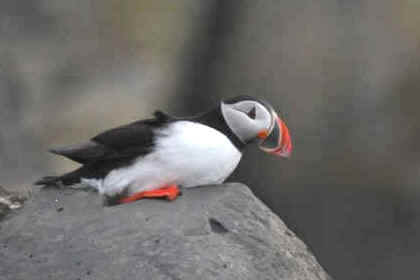
An Atlantic Puffin
photographed
during the FONT tour
in Iceland in June 2012
Links:
A Photo Gallery of Iceland Birds & Other Nature during our June 2012 FONT Tour
List of Birds & Other Wildlife during our Iceland Tour - June 2012
Birds during previous FONT Iceland Tours
A
Complete
Iceland Bird-List
(383 species, including vagrants from mainland Europe, Asia, & North
America)
Wildflowers of Iceland (with some photos)
Upcoming FONT Birding & Nature Tours in Iceland
A following narrative was written by Armas Hill, leader of the tour:
During over two decades, there have been FONT birding and nature tours on varied islands
throughout the world, including those in places as far-flung as the Caribbean,
Japan, and Iceland.
In the Caribbean, we've been to Barbuda
and Barbados, Dominica
and the Dominican Republic, Saint
Lucia and Saint
Vincent, as well as the Caymans, Jamaica,
Puerto Rico, and Guadeloupe.
Off the west coast of the main Japanese island of Honshu,
we've been, over a half-dozen times, on the tiny island of Hegura,
in the Sea of Japan, where in the spring,
bird migration has been extraordinary. And we've seen specialty birds and
butterflies on the small Japanese islands of Amami
and Okinawa.
But different than any other island we've visited has been
Iceland, a place with fire and ice and much in between, and many
birds. As of our June 2012 tour, we've
done 18 tours in Iceland.
Iceland, about the size of the US state of
Kentucky, has with it a number of smaller islands. During our
June 2012 Iceland Tour, we visited
two especially notable, Flatey and Heimaey.
Flatey is one of over 2,000 islands in the
big bay in western Iceland with a big name, Breidafjordur.
Like Hegura in Japan,
Flatey Island is very small, only about a
mile long and less in width, and with only a very few motorized vehicles, almost
none. Cars can not exit the ferry onto Flatey,
as they can not onto Hegura. On Flatey,
we saw two tractors and one small utility truck.
In the small village, there are some wooden buildings painted various colors.
The place is picturesque. Our weather was superb, making our time on the island
and the setting and scenery equally so.
Only 4 people live year-round on Flatey. The
other cottages, along with a small hotel and restaurant, are only in use in the
summer.
Whereas people are few on Flatey, birds
are many.
As we walked along the lane, as noted without as stated a car in sight, there were some Red-necked
Phalaropes walking on the road with us, catching some small little insects
as they went, on the ground and on roadside flowers. Those little phalaropes
were literally at our feet. Others were on nearby pools of water spinning around
as phalaropes do.
On the roof of one of the small houses, a male Snow Bunting sang a
beautiful song. Nesting Snow Buntings are rather common on Flatey.
In the air, above us, Common Snipes were displaying, or winnowing in fast
flight, with the reverberating sound that comes from from their wings. Another
shorebird, or wader, the Common Redshank continuously scolded us as we
walked along our way. Even better at scolding were the Arctic Terns.
"Shrieking" would a more appropriate word for them, and even though
there's no "Common" as an adjective in their name, they were.
Along the mostly-rocky coastline, there were Common Eiders, many of them,
and mostly with their little ones, eiderettes.
Also among the birds along the coast, there were European Shags, that we
watched fly, fish and swim.
As we sat on some coast-side rocks, Black Guillemots in breeding plumage,
with their black bodies, white wing-patches, and red feet, were beside us, or on
the nearby water.
As we sat on a grassy bluff by the sea, Atlantic Puffins, with their
bright red feet, were below us on the water. Others flew out from their burrows
between the seaside rocks. Northern Fulmars flew out from their stony
perches.
Flatey was a wonderful place to be, and
during our entire time there the birds that were always around kept reminding us of their
presence. In all, we saw 18 species of birds on the island. But it wasn't so
much that we saw 18 species. It was that we "experienced"
them.
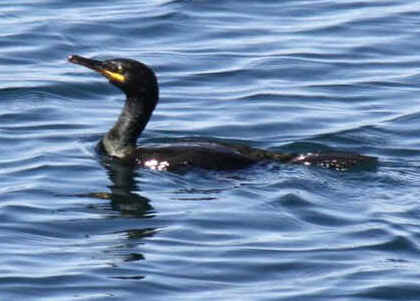
A European Shag swimming
off the shore of Flatey Island
during our Iceland tour in June 2012
Heimaey Island is one of 15 small islands
off the south coast of Iceland known collectively as the Westmann
Islands, or in Icelandic, Vestmannaeyjar.
The islands are said to have been created entirely by volcanic activity, after
the end of the last glaciation and since. Most recently, the 15th of the
islands, named Surtsey, was created during a
submarine eruption between 1963 and 1967.
Heimaey is the largest of the Westmanns,
and the only island of the group inhabited by people. All of the islands are
inhabited by birds, notably seabirds, with many of them nesting on
sheer cliffs.
Under 3 miles in length, Heimaey Island has
had some dramatic volcanic history. In January 1973, an eruption began there,
just beyond and above the one town on the island. The entire population of about
5,000 people was successfully evacuated during one night by boat and plane. The
eruption continued until May. Lava flowed down into the streets. About half of
the town became submerged by it. During our visit in June
2012, we saw remnants of houses now covered
by volcanic soil where flowers, notably Lupin, flourish.
The Westmanns, including
Heimaey Island, are, as just noted, the haunts of many nesting
seabirds.
During the ferry ride to and from, and near the islands, we saw Manx
Shearwaters, Northern Gannets, Great Skuas, Parasitic Jaegers, and gulls,
along with many Arctic Terns, Black-legged Kittiwakes, Northern
Fulmars, and numerous alcids including Common Murres, Razorbills,
and Atlantic Puffins - a plethora of puffins.
Manx Shearwaters breed in Iceland only in the Westmanns,
and the Gannet and the Great Skua are most commonly seen in
Iceland along and off the southern coast.
But it was in far-northwest Iceland where we saw the most seabirds. At the
western end of a rugged peninsula, at the western end of Iceland that is also
the western end of Europe, we visited the Latrabjarg
Cliffs. From there, it is about 300 miles across the sea to the
hyperborean coast of Greenland.
The Latrabjarg Cliffs are massive and truly
one of the most impressive places anywhere in the world, and especially so for
those who like being where birds are.
The cliffs rise to over 1,650 feet above the ocean, and they continue for 12
kilometers, or 7 and a half miles. And they teem with nesting seabirds
including a huge number of alcids, fulmars, and kittiwakes.
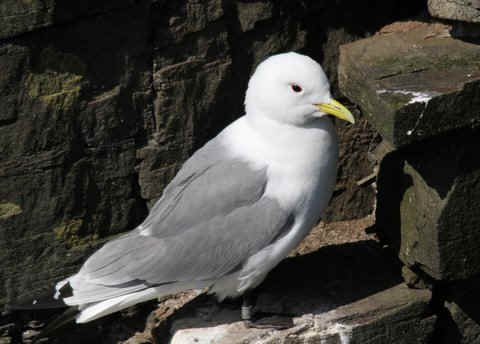
A Black-legged Kittiwake
photographed during our June 2012 tour in Iceland
Among the alcids at Latrabjarg, there
are tens of thousands of Thick-billed Murres (known in Europe as Brunnich's
Guillemots), alongside vast numbers of Common Murres (known in Europe
as Common Guillemots).
About 40 per cent of the Common Murres in the North Atlantic breed in
Iceland with, it has been said, over a million pairs. About 75 per cent
of the Common Murres that breed in Iceland
do so on the 3 largest bird-cliffs of the western fjords of northwestern
Iceland. One of those 3 cliffs is Latrabjarg.
Those same 3 cliffs in northwestern Iceland,
including Latrabjarg, are the nesting sites
of about 90 per cent of the Thick-billed Murres that breed in Iceland,
and that area has the largest number of Thick-billed Murres in the North
Atlantic. It has been said that about 580,000 breeding pairs of Thick-billed
Murres nest in Iceland.
An estimated one-third of the world's Razorbills nest at
Latrabjarg. We saw them nicely on the ledges, either standing erectly
or resting on their bellies.
The Razorbills at Latrabjarg
constitute the largest known colony of the species in the world. About 60 per
cent of Icelandic Razorbills breed there. The population of Razorbills
in Iceland has been said to be an estimated
380,000 breeding pairs.
But it is the Atlantic Puffin that is the star of the show at
Latrabjarg. Late in the day, atop the cliffs, there are just so
photogenic. And so tame, allowing humans to be unimaginably close to them.
I watched people lying on the ground as they photographed the Puffins.
The lying people and standing birds were
eye-to-eye.
I couldn't help but observe as I watched the few dozen people who were there,
either lying on the ground or walking on the dirt path,
within reach of the Puffins, that they certainly were smitten by them.
All the people noticed, of course, the impressiveness of the place and the swarms of seabirds
on the cliffs, in the air, and in the water. But it was that "chorus
line" of sorts of continuous Puffins, one after the other, and so
very close, that got the most attention from person after person. People
certainly liked the "Sea Parrots", as Puffins are also
called.
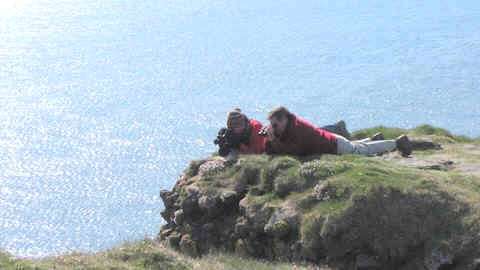
Looking at the seabirds on the
cliffside.
1,650 feet above the ocean,
during our June 2012 tour in Iceland
Following here are some other birds with which we had notable experiences during our June
2012 Iceland Tour:
About half of the Great Skuas in the world breed in Iceland,
with an estimated 5,000 pairs. Most nest on barren ground along the southeastern
coast.
One of the Great Skuas, that we saw in that region of Iceland, was very
close to us in a pool alongside the road. Seemingly it was holding down some
prey in the water. The big, dark bird with the splashing is what first caught
our attention. After that went on for a while, however, the Skua lifted
up into the sky but with nothing in its talons.
Late the previous evening, we had watched two dark-morph Parasitic Jaegers
(or Arctic Skuas) methodically creating havoc among Arctic Terns,
and some gulls and shorebirds (or waders), as they, the jaegers
that is, continuously and quickly flew around above the other birds nesting on
the grassy ground. But in the end, at least as long as we were there, those
Parasitic Jaegers came up empty-taloned as well.
Nearby, another predator was in the air and then on the ground, a Short-eared
Owl.
Red-throated Loons (or Red-throated Divers) in their breeding
plumage as they floated on a pool of still water, were, with whatever name,
memorable.
Actually, they were beautiful with their burgundy-red throats, light-gray heads,
and the lines on the back of their necks. But when that species vocalized, it lacked
the beauty of the sound of the Common Loon (or Great Northern
Diver) that we also saw.
The Common Loon nests in Europe only in Iceland, and two other birds also
have that same distinction, the attractive Barrow's Goldeneye, and the
more than attractive Harlequin Duck. The colorful male Harlequin
is downright gaudy.
But the most fascinating aspect of the Harlequin Ducks that we watched
was how they swan so well underwater in a very swift river. Both males and
females did so together in pairs. But the female appeared to stay underwater
longer in the fast current.
The Barrow's Goldeneye and Harlequin Duck were just two of the
species of waterbirds that we saw in the area of Lake
Myvatn in northern Iceland. That lake is said to have the most
nesting ducks of any lake in the world.
One of the most colorful of the waterbirds that we saw there was the Horned
(or Slavonian) Grebe in its bright breeding attire. How many birds are
there with bright yellow-orange head plumes?
Lacking much color were the Glaucous Gulls and Iceland Gulls that
we saw saw along the coast in northern Iceland. They were all-white, with one
species, the Iceland, a smaller version of
the other.
The Glaucous Gull is quite common in that area.
The Iceland Gull was not, as we were there in June. The Iceland Gull is
more common in Iceland in the fall, winter,
and spring. Actually, the Iceland Gull does not nest in Iceland.
It does so further north, in Greenland. A
few, mostly non-adults, linger in Iceland in
the summer.
In the highlands of north-central Iceland, we enjoyed the Pink-footed Geese.
Generally they were timid birds, keeping their distance, but we saw a nice
number of them well. We saw flocks of Pink-footed Geese, and a few, at
various places, with their young.
A book that I like is entitled "In Search of the Pink-Headed Duck",
referring to a duck now thought to be extinct that was in India. In the book, the searchers
found much, but not the non-existent duck.
However, the Pink-footed Goose can be found, as we did find it, in the
wild highlands, where no people live, in Iceland.
Also in that area, at some ponds, we found breeding-plumaged Purple Sandpiper,
and also in their breeding attire, Long-tailed Ducks.
The Purple Sandpiper does not nest along the coast, and where and when
the species does, it is the male that rears the young, with the same role also
had by male Red-necked Phalaropes that were also with nesting territories
in the same area where we found the Purple Sandpiper.
Female Red-necked
Phalaropes have more color and a bolder pattern in their breeding plumage
than the males.
The Long-tailed Duck has just been classified by Birdlife International
as a "vulnerable species", as globally its population has been
declining. That is unfortunate, as it is such a beautiful bird, both the male
and the female, and both in and out of breeding plumage.
Another bird that is as "non-existent" now as the Pink-Headed Duck
is the Great Auk. It did live, formerly, in
Iceland, and in fact the last known Great Auks lived there.
From the top of a cliff along the south coast of Iceland, we could see the
offshore island where the last Great Auks died in 1844. Where we were on
that cliff-top, there is now a large sculpture of the bird.
Returning to the Pink-footed Goose, and a positive thread: The total Pink-footed
Goose population of Iceland and
Greenland combined, in the autumn, has grown ten-fold during recent
decades, from about 23,000 birds in 1952 to 230,000 birds in 1995. Most of those
birds winter in Scotland and northern England. They depart from Iceland
in October.
I've noted that during our June 2012 tour in
Iceland that we saw the goslings of Pink-footed
Geese and the ducklings of Common Eiders.
Among other birds that we saw as youngsters with adults were those of Greylag
Geese, Eurasian Oystercatcher, White Wagtail, and Snow
Bunting, in addition to cygnets with Whooper Swans.
In addition to the displaying of many Common Snipe, high in the sky,
there were flight displays, again and again, both in the video and audio mode of
European Golden Plover, Common Redshank, and Whimbrel.
Among passerine songsters during the tour, there were two Turdus
thrushes, the Redwing and the Blackbird.
The former is common throughout Iceland. The
latter is a recent addition to the spring and summer Icelandic avifauna. It is
localized.
Outside, one day, where we were having a lunch inside, there was, on the other
side of the window, a nice grouping of Redpolls, also feeding on food
provided for them.
The resident endemic subspecies of the Common Redpoll in Iceland is Acanthis
flammea islandica, sometimes referred to as the "Icelandic
Redpoll".
Another day, after our dinner, in a field behind the restaurant, there were Ptarmigan.
First, a male Rock Ptarmigan was nicely in clear view on a rock,
posing in the light of the late-day sun. Then the female appeared, equally as
nice to view in that late-day sunlight. Not far from the nest, she also posed
for a while, before slipping back to it in the grass. What a great experience
that was - seeing the Ptarmigans as we did, with both Snipe and Whimbrel
displaying around us, by a high hillside next to a pristine seacoast in
northern Iceland - after having yet another good, Icelandic
meal.
The Rock Ptarmigan in Iceland in the
summer is an endemic subspecies, Lagopus mutus islandorum. In all,
globally, there are 27 subspecies of Rock Ptarmigan, with most on islands
or in other remote places.
Yes, there were birds during our June 2012
Iceland Tour - many of them. But, as probably it has been conveyed here,
there were not just birds.
We also saw the cliffs, volcanoes, waterfalls, glacial lakes, icebergs
from a calving glacier, hot springs, boiling mud pools, steam vents
and other geological phenomena, and innumerable wildflowers.
In conclusion, some comments now about mammals we observed that included
both Harbor and Grey Seals, Arctic Foxes, Reindeer,
White-beaked Dolphins, Northern Minke Whales, and Blue Whales:
We saw 3 Arctic Foxes. One was all-dark, the "Blue Fox",
and two had white, or "off-white" tails. Later in the year, some Arctic
Foxes in Iceland are all-white, as we've seen during our tours there in October.
We saw Reindeer, as we traveled, in 3 groups. The animal, with its
scientific name Rangifer tarandus, is called Reindeer in Europe
and the Caribou in North America.
It was first introduced into Iceland in
1771, with 13 individuals from northern Norway. There were no further
introductions.
Numbers increased and peaked in the mid-19th Century. The population then
declined rapidly, until less than 200 were left in 1940.
Now, only in eastern Iceland, numbers have
increased again, and are stabilized at about 3,000.
Off the north coast
of Iceland, with a scenic backdrop of snow-topped mountains and
coastline, we had the very good fortune of seeing two magnificent creatures, two
Blue Whales.
The Blue Whale is the largest of all living creatures on Earth. And it is
the largest ever known to have existed.
It can be with a length of 100 feet and the weight of up to 150 tons. We saw
well portions of the bluish-gray backs of both animals, their fins, and the huge
flukes of their tails before they dove. We were able to stay with them for 3 of
their dives, each of which lasted about 10 minutes.
So big and so rare is the Blue Whale. It is estimated that only about
1,500 exist in the North Atlantic Ocean, with also about that same number in the
North Pacific Ocean. The Antarctic population is said to be only about 6,000
individuals.
The Blue Whale in the northern oceans is one of 3 subspecies, Balaenoptera
musculus musculus. It is believed that the populations, or subspecies, in
the Northern & Southern Hemispheres never meet.
We were so lucky that our path, as we did a counter-clockwise "circle
tour" around Iceland, and the path of
the Blue Whales did meet.
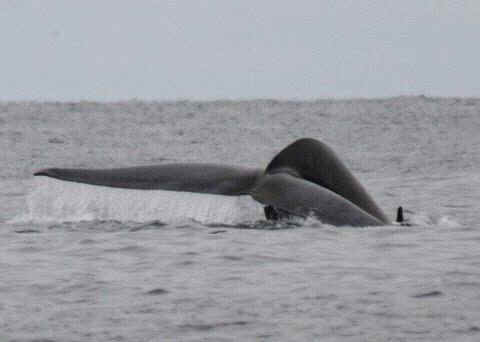
A Blue Whale photographed
during the June 2012 FONT tour in Iceland.
1 of 2 Blue Whales that were seen.
The Blue Whale is classified as
a globally endangered species. Following
the slaughter of 30,000 of them in the Antarctic season of 1930-31, the
population never really recovered. But at least, now into the 21st Century, it
is not extinct.
When the big Blue Whale was given its scientific name by Linnaeus in
1758, it sometimes is thought of as 18th Century humor, as the Latin "musculus"
means "little mouse". But that word can also mean "muscle"
and that would be appropriate for the largest animal the world has ever known, that
constantly swims and dives deeply in the ocean.
Also during that same sea-trip off northern Iceland,
we saw at least one Northern Minke Whale and a couple pods of White-beaked
Dolphins, along with a Pomarine Jaeger (unusual for Iceland) and
numerous Arctic Terns, Northern Fulmars, some Common Murres, and
again Puffins, with many of them, in groups, sitting on the surface of
the sea and then sometimes flying and more often diving.
Yes, we were fortunate to see the Blue Whales, but also fortunate to see
and experience so much else during our June 2012
Iceland Tour, that was the 56th FONT tour in Europe
and the 18th in Iceland.

A traditional Icelandic
lunch
in the northwestern fjords region
during a FONT Iceland Tour